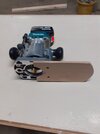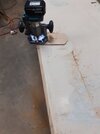- Joined
- 8 Feb 2015
- Messages
- 241
- Reaction score
- 7
- Country

Hi all
Am building a desk.
Plan on using a thick melamine board for the body of the desk, onto which I'd attach (via glue/nails) a decorative real-wood strip/fascia around it's edge.
I'd like to avoid having a noticeable 'lip' between the board and the fascia, as you'd likely see/feel it as you rest your arms on the edge as you work.
Does anyone have any idea how I could ensure the two are exactly the same level and the join between them is smooth?
Obviously if both were real wood then I'd simply sand the join, but as the main body of the desk is melamine, then I can't sand that bit.
Any advice much appreciated!
Am building a desk.
Plan on using a thick melamine board for the body of the desk, onto which I'd attach (via glue/nails) a decorative real-wood strip/fascia around it's edge.
I'd like to avoid having a noticeable 'lip' between the board and the fascia, as you'd likely see/feel it as you rest your arms on the edge as you work.
Does anyone have any idea how I could ensure the two are exactly the same level and the join between them is smooth?
Obviously if both were real wood then I'd simply sand the join, but as the main body of the desk is melamine, then I can't sand that bit.
Any advice much appreciated!


